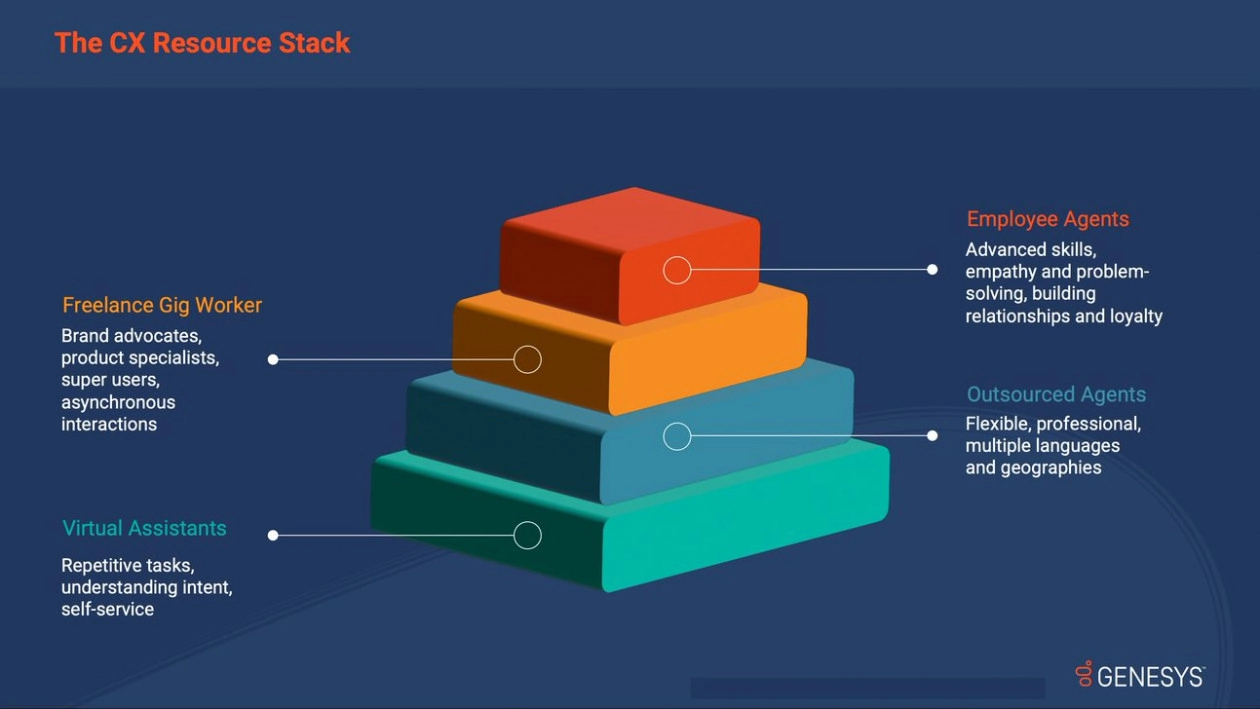Your Genesys Blog Subscription has been confirmed!
Please add genesys@email.genesys.com to your safe sender list to ensure you receive the weekly blog notifications.
Subscribe to our free newsletter and get blog updates in your inbox
Don't Show This Again.

Customers who contact a brand to get information or resolve an issue want deep expertise and fast service. But it can be difficult to consistently meet those demands.
Interaction volumes are rising much faster than most organizations can hire or grow their budgets to accommodate. High customer experience employee turnover rates and an ongoing talent shortage make it difficult to have enough highly skilled workers to engage customers quickly, thoroughly and in their channels of choice.
Technologies like chatbots and IVRs provide self-service alternatives that can help reduce the number of agent interactions. But too often, automated interactions are siloed, creating disjointed experiences for customers who need to escalate to a live-agent interaction. Instead, bots, IVRs and humans should augment each other by operating in unison.
Research has shown that not only is the voice channel here to stay, but it becomes more important in uncertain times. During the COVID-19 pandemic, one in six surveyed Americans called customer service just to hear a human voice.
So, with a potential cost-of-living crunch ahead, the challenges of staffing and rising interaction volumes could collide again. That’s why now is an ideal time to develop a resourcing strategy that drives efficiency while improving both customer and employee experiences.

In today’s modern customer experience (CX) organization, there are four building blocks that typically form the “resource stack”: in-house customer experience agents, regular contracted outsourced agents, “gig workers,” and automated assistants like chatbots and IVRs. Each has a specific skill set. For example, bots are the best at replication and intent gathering, while humans excel at empathy, humor and persuasion.
As the types of interactions shift, agents are seeing an increase in more complex inquires, and this will only continue. Agents are quickly becoming knowledge workers — something supervisors must consider as they plan their staffing and routing.
By using technology to correctly understand and route interactions, you can connect the customer to the right resource at the right time. This approach also allows each group to become more relevant as they each handle interactions based on their specific areas of expertise.
At the bottom of the resource stack are chatbots and voicebots; IVRs; workflow automations; and micro apps used within workflows to the back office or as the first point of customer service interaction. Organizations can use bots to triage inquiries, and then either handle basic ones or forward more complex ones to the right agent.
Examples of workflow automations include address changes, billing, offer comparisons, intent gathering, opening accounts and filing claims — almost any basic, common action that doesn’t contain exceptions. Micro apps include a billing app used after completing a transaction, an address change app or any app that automates simple tasks formerly performed by an agent.
When employee agents control and manage the use of micro-apps, it empowers them and makes the interaction more efficient, effective and empathetic. For the rest of the resource stack to work effectively, virtual assistants must understand and predict intent, then effectively transfer context to assist the human agents.
An increasing number of organizations are using gig workers in the customer experience. These workers, sourced through gig work platforms, are typically brand advocates or super users who organizations hire on-demand to share their expertise with other customers. As freelancers, they own their schedule, which provides them with tremendous flexibility to handle interactions when they want to.
Companies benefit from these individuals’ specialized expertise, but this approach typically requires building up a “crowd” of gig workers, so the system works effectively. Although gig workers do handle voice interactions, they are often deployed on messaging services for live chat.
Some people like to speak to a person, even for simple interactions. They expect a friendly and efficient person who can handle their inquiry and give them the assurance they need. To meet that need, handle spikes in volume and meet SLAs consistently, many organizations use outsourced service providers.
Indeed, the recent MIT report “Customer experience and the future of work” suggests that regular contracted staff represent an average of 23% of an organization’s CX workforce today.
At the top of the stack are in-house customer experience agents — either full- or part-time employees. When the resource stack is working effectively, these agents will be managing the interactions that are most tied to increasing customer loyalty.
They’ll use their emotional intelligence, patience, humor, problem solving and empathy. They’ll have deep knowledge of the organization and its processes.
However, the MIT report noted that dealing with frustrated customers and high stress were significant challenges for CX employees. As such, managers need to balance workloads and mix up the types and complexity of interactions to avoid giving any employee an excessive cognitive or emotional load.
Making the stack work seamlessly requires technology in front of the agent to gather intent, route interactions intelligently and transfer customer context. It requires having technology alongside the human agents to assist them in the moment, identify training and coaching needs, and monitor their performance. It also requires technology behind the employee to lower administration and allow them to focus on what matters.
This approach not only supports agents, but also orchestrates better customer journeys. As customers move through an omnichannel service journey, an organization can direct each customer to the right type of agent based on their behavior, need and intent. For example, a chatbot can triage a customer who needs product expertise to a gig expert, while a customer with a more complex question about their account. Billing could be routed to an employee agent with understanding about internal processes.
Organizations should build and link these four resource types to avoid repeating past mistakes. By taking the time to truly understand the intent and the journey of every customer, organizations now can resource with precision. Plus, adjusting your resource stack to include and connect these four groups is the smart way handle increasing volumes with predictable staffing budgets.
However your CX workforce is comprised, the MIT report identified several priorities for all staff. Customer experience agents need more information to assist customers in the moment; more help in managing frustrated customers (or, ideally, fewer already frustrated customers); more meaningful learning and development opportunities; and better platforms to make their work easier.
The survey found that employers are taking note by investing in simplifying the employee interface, using AI across the employee journey, and bolstering learning and development programs. The goals for these investments are to make CX work more strategic, engaging, purposeful and marketable — all of which is critical for developing a culture of empathy toward customers and employees.
Subscribe to our free newsletter and get blog updates in your inbox.